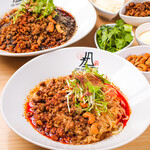
175°DENO担担麺 TOKYO
hyakunanajuugododenotantammen ◆ ヒャクナナジュウゴドデノ担担麺
3.52
Shinjuku
「Dandan Noodles」
1,000-1,999円
1,000-1,999円
Opening hours: Monday, Tuesday, Wednesday, Thursday, Sunday 11:00 - 21:45 LO. 22:00 close Friday, Saturday, and days before holidays 11:00 - 22:45 LO. 23:00 close 175GINZa (Ginza Store) also available. Open Sundays
Rest time: nashi (Pyrus pyrifolia, esp. var. culta)
東京都新宿区西新宿7-2-4 新宿MSビル 1F
Photos
(20)
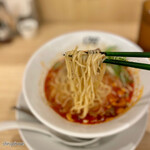
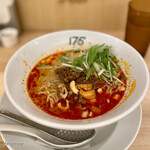
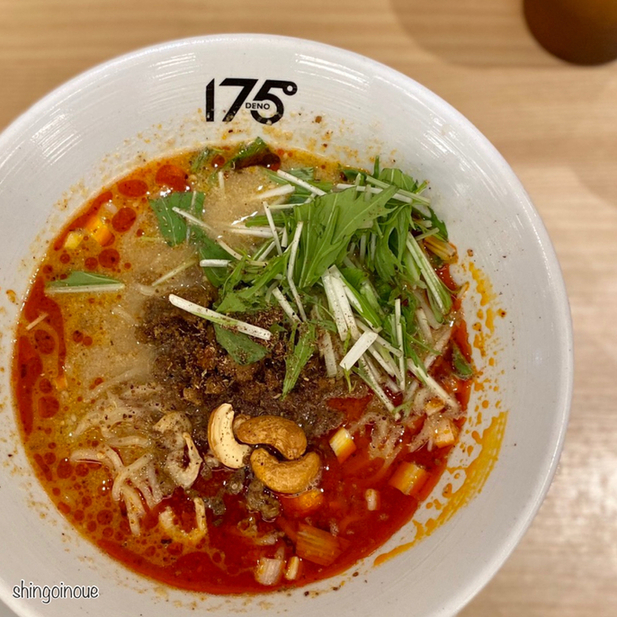

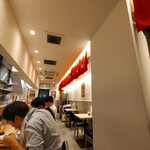
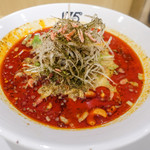
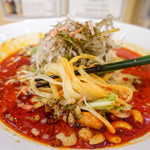
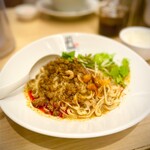
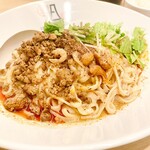
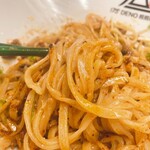
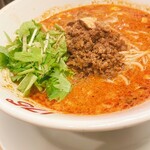
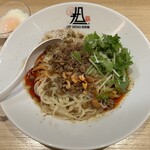
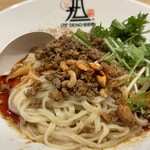
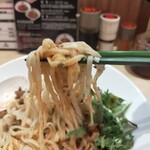
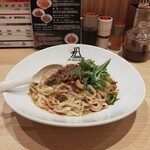

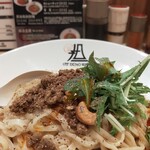
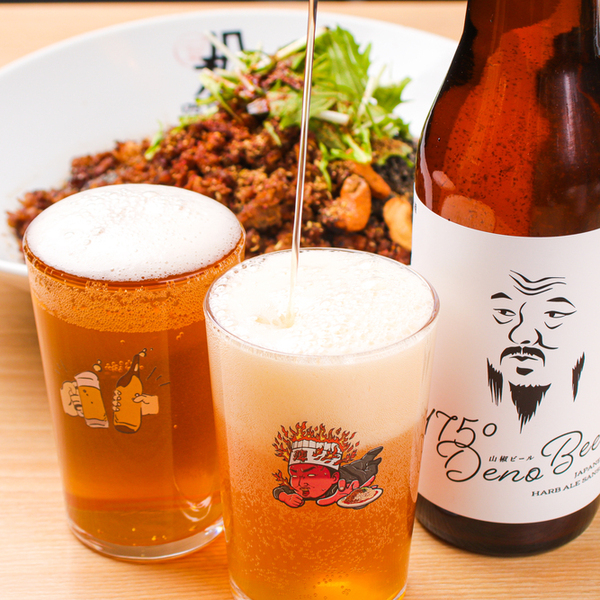
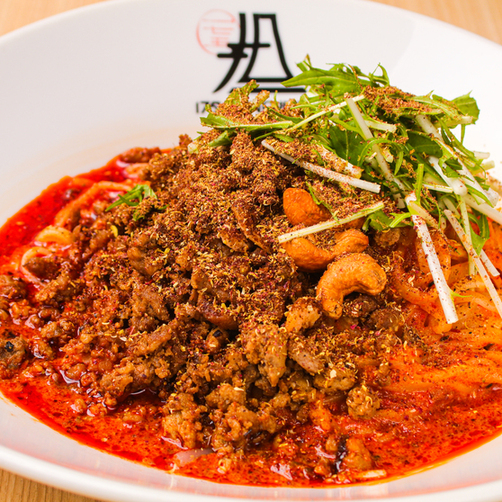

Details
Reservation Info
No Reservations
Payment Method
No credit cards
Electronic money is not accepted
QR code payment is acceptable
(PayPay, d-payment)
Number of Seats
22 seats
(14 seats at the counter and 4 tables for 2 persons)
Private Dining Rooms
None
Smoking and Non-Smoking
No smoking at the table
Parking
None
Facilities
Stylish space, calm space, counter seating available.
Dishes
Health and beauty menu available, English menu available, allergy labeling available
Comments
(21)
vgainr1rc
4.00
[Overall Impression] Despite being level 1 in numbness, the Szechuan flavor was sufficient and addictive! The sesame flavor is rich, with a perfect balance of nutty aroma, spicy chili, and Szechuan pepper numbness. With plenty of minced meat, it is very satisfying. The flat noodles are excellent at absorbing the sauce, making it a top-notch dish! I was impressed by how famous this place already is when I thought it was the best.
[Basic Information]
Visit Date: 09/19/2023 (Tue) 11:15
Queue upon Arrival: 0 people
Ticket Purchase Method: Purchased through a touch panel
Order/Amount: Soupless Tantanmen (Spiciness and Numbness at Level 1) + Small Rice
[Soup]
At the bottom of the container is a sesame sauce that adds a rich sweetness. The red-tinged chili oil provides a striking impact, and the high level of completion is evident visually. The special Szechuan pepper adds a nice numbness, and it was delicious.
[Noodles]
The flat noodles are chewy and have a firm texture, allowing them to absorb the rich soupless Tantanmen sauce well. Be sure to mix thoroughly to ensure the ingredients and soup coat the noodles evenly. As you eat, you'll notice a change in the rich flavor, making it a delicious noodle dish.
[Ingredients]
Plenty of minced meat (stir-fried meat) is used generously, making it very tasty. Additionally, the use of unique ingredients like cashew nuts caught my attention. Other ingredients include dried shrimp and watercress. The overall balance of ingredients shines.
[Side Menu]
Rice is a must with the soupless Tantanmen!!
[Service]
Paper aprons are available next to the water dispenser. The staff also announces when purchasing tickets. They confirm the spiciness and numbness when you hand over the ticket. There are homemade condiments like chili oil on the table, which was very delicious.
[Atmosphere]
The counter-centered layout is very clean and has a sense of cleanliness. Homemade condiments are also available for sale, and the layout of the shelves is stylish. The staff has a friendly atmosphere, making it easy for a solo female diner to enter. *Thank you for always reading! I would be happy if you could [like] and [save] this post if you enjoyed it (≧∀≦)




おぢさんふぇすた
3.80
Today's ramen is "175°DENO Tantanmen TOKYO" in Shinjuku Nishiguchi. This ramen shop has quite a few branches in Tokyo. The main store is actually in Hokkaido. Hokkaido is known for its regional ramen styles like Sapporo miso, Asahikawa shoyu, and Hakodate shio. I wonder what the taste of Tantanmen, which originated in Hokkaido, is like. Recently, there has been an increase in ramen shops closing down, mainly due to rising ingredient costs and labor expenses creating a barrier at the 1,000 yen price point. Japanese people tend to tighten their wallets when it comes to paying over 1,000 yen for ramen. Despite the effort and quality put into the ingredients and preparation, the brain tends to resist paying that amount for ramen. Ramen is deeply rooted in Japanese culture as a comfort food for the masses, making it difficult to break the 1,000 yen barrier. The reason why people can pay over 10,000 yen for French cuisine at a hotel or traditional Japanese food at a high-end restaurant but hesitate with ramen might be because ramen doesn't require an elaborate setting, service, or time investment. Ramen is all about being fast, affordable, and tasty. It doesn't need wine pairings or lengthy conversations. People just want to eat quickly and leave. There's no reason to pay 1,000 yen for a 15-minute meal. Today, I chose a ramen with soup, opting for the spicy Sichuan pepper level 2 (with 6 extra peppers), spice level 1, and a rich chicken broth base. The noodle portion was a regular 260g. After a 15-minute wait, the ramen arrived. The Tantanmen looked promising, especially with the extra Sichuan peppers. The wait had my mouth watering in anticipation. First, the soup. With the spice level toned down, the sesame and chili oil flavors were prominent, complemented by the crunch of the green onions. Next, the noodles. They were straight and thin, not particularly distinctive, but tasted great with the cashews and minced meat. The subdued spiciness allowed the Sichuan pepper to shine, tingling my lips and tongue. The authentic Sichuan peppers sourced directly from Sichuan added a unique kick. It was interesting that the background music in the restaurant was bossa nova.
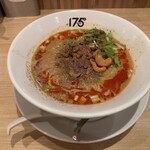
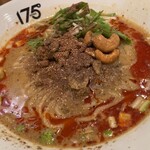
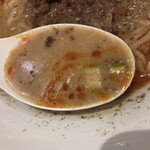
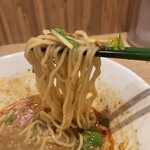
jnglog
3.40
No broth tantanmen with onsen egg for 1,150 yen
I visited this place after watching the rerun of "Would you like us to warm up your onigiri?" in Sapporo. The brothless noodles were surprisingly flat. They were different from the typical brothless tantanmen noodles. The noodles were high in water content, chewy, and delicious. I chose level 1 for the numbing spiciness, which was just right for me. You can adjust the numbing spiciness by adding more Sichuan pepper on the table. Next time, I will try the Jiro-style menu. Thank you for the meal.


なのゆに
3.50
The food was delicious, but I'm sorry. It was completely my fault that I couldn't fully enjoy this restaurant. I love Sichuan peppercorns and often use them in cooking, so I was excited to see that this restaurant allows you to choose the level of Sichuan peppercorns from 1 to 30. Thinking I was being conservative, I chose level 15 and regretted it. It was a different kind of spiciness from chili peppers... lesson learned, moderation is key. I would like to go back and try a different level next time.

9cd9e9
3.00
The soup is made with regular tantanmen oil, adding a junky feel to make it like Jiro-style ramen. The rich oil and chashu are quite delicious and junky, but the noodles are not that great. Perhaps due to the Jiro influence, the noodles are thick, but the soup completely overpowers them, resulting in a delicate balance.
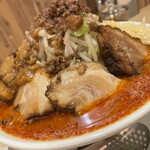
みっち
3.40
I went to 175°DENO Tantanmen TOKYO, a Tantanmen specialty shop in Shinjuku, Tokyo. They use a base of spicy oil cooked at 175℃, as their name suggests. It's recommended to mix the noodles well before eating. You can mix in cashew nuts and a meat miso-like topping. The sesame flavor is not very strong, and the spiciness is just right. It's similar to Hiroshima-style soupless Tantanmen. Next time, I'll try the soup version.


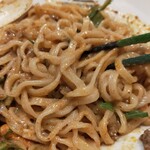

edhardy
3.50
I came back to the same shop again and had the Kuro Miso Ramen. I think the opening time was 11:30, but I'm not sure. Anyway, I'm happy that they open at 11, so I'll have more chances to visit. Today I had the soup-based Tantanmen (spicy) with half rice. It looked delicious as always. I mixed it well and the noodles were chewy and tasty. The level of spiciness and numbness was just right for me. The minced meat seemed to be less than before, but maybe it's just my imagination? Also, the broth didn't seem as flavorful as last time. Overall, I had a lot of "maybe it's just my imagination" thoughts. I finished by adding the half rice to the remaining soup after finishing the noodles. I'm satisfied with the delicious Tantanmen.
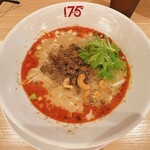

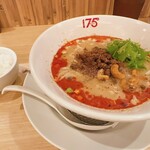
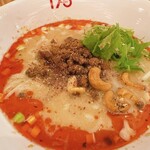
すけ!!
3.00
Recently, there has been an increase in restaurants serving soup-less tantanmen. Today, I visited a shop in Shinjuku. They offer both soup and soup-less options, and I chose the soup-less version for 1,000 yen. You can choose the level of spiciness and numbness. I ordered it extra spicy and numbing. The flavor was delicious, and the portion of noodles was generous, which is great for young people. The noodles were a bit hard to pick up with chopsticks because they were stuck together, but that's understandable. The numbing sensation from the sansho pepper was irresistible. I highly recommend it for those who enjoy numbness.
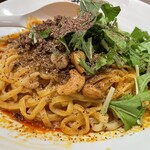
おむ
3.70
After drinking, we headed to "175°DENO Tantanmen TOKYO" for our last meal. Jiro didn't go in, probably because it was close to closing time and many menu items were sold out. I chose the "Sesame Soupless Tantanmen (1000 yen)" and bought a meal ticket. When it arrived, it was topped with plenty of minced meat, watercress, shrimp, and nuts. The spiciness and heat were just right, making me slightly choke at first. The noodles were chewy and delicious, and surprisingly filling. I even managed to finish it all, adding a bit of black vinegar towards the end for a refreshing touch. My companion ordered a gyoza, which was hot, juicy, and full of garlic flavor. The chopsticks had a stylish bamboo design. Overall, it was a satisfying meal. Payment was cash only.
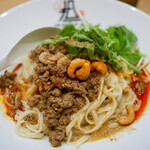
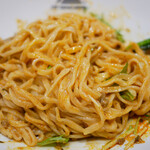
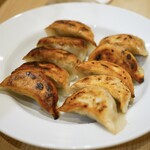
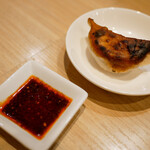
かーくん4008
3.70
The menu mentioned that there is a choice between regular and rich base, and I opted for the regular one since they didn't offer the rich option. Even though I selected level 1 for both numbness and spiciness, the numbness was surprisingly strong. It felt similar to when your foot falls asleep, temporarily losing sensation. Other than the numbness, the soupless tantanmen was delicious as usual. Overall, it was a decent meal without any particularly outstanding features.
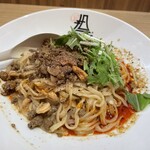
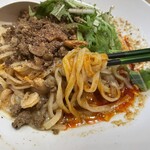

たなか283
3.80
I visited "175°DENO Tantanmen TOKYO" located about a 3-minute walk from Seibu Shinjuku Station around noon on Saturday and was able to enter without waiting in line. You can choose the level of numbness and spiciness according to your preference! I ordered the "White Sesame Soupless Tantanmen" with numbness level 2 and spiciness level 1. The numbness level 2 was quite intense as they directly source Sichuan peppercorns from producers in Sichuan province, which give a tingling sensation and have addictive properties. (For those who are not fond of numbness, the recommended level 1 is better). I personally felt that a bit more spiciness would be good, so next time I will order numbness level 2 and spiciness level 2. The chewy flat noodles, minced meat, crispy watercress, and fragrant cashew nuts were excellent!【Menu】White Sesame Soupless Tantanmen Numbness: 2 Spiciness: 1
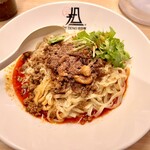
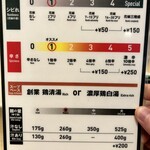
hipstar11
4.00
I used to live in Sapporo and there was a restaurant I liked. After moving to Tokyo, I knew they had a branch in the city but couldn't visit it easily. I originally planned to have soupless ramen, but due to my hunger at the time, I chose Ichiro! I was satisfied with the fullness, as well as the spicy and rich flavors of the tantan noodles.
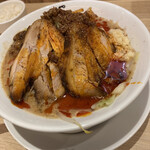
haya_932
4.00
I ordered the tantanmen without soup. I chose a spice level of 2 and numbness level of 2. It was incredibly delicious! There were whole Sichuan peppercorns, vinegar, and chili oil on the table, and when I added the chili oil, it became properly spicy. The restaurant was clean and I appreciated the paper aprons provided.
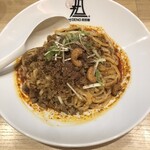
飯!食わずにはいられないッ!
3.60
I arrived at the entrance at 3:58 PM and immediately purchased a ticket for Inagorou for 1300 yen. When the staff asked for my order, I requested the Inagorou without garlic, but it seems that by default it comes with garlic unlike the main branch G? J?. My companion felt sorry for me as they had ordered with garlic. I was also asked about the level of spiciness and numbness when placing the order at 1.1. The donburi and soup that arrived at 4:09 PM were delicious, with the soup's minced meat adding to the flavor, giving an inspired taste similar to miso ramen. The noodles had a slight chewiness and were somewhat average, but overall the dish was tasty. The seasoned oil salad was also delicious. Thank you for the meal. It was so delicious that I want to come back next time to try the regular menu.
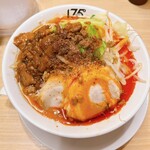
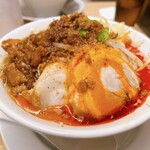
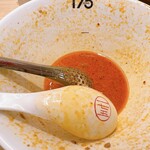
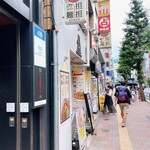
Grm歩き
3.40
I visited this shop located about a 5-minute walk from Seibu Shinjuku Station. The shop originates from Sapporo and specializes in tantanmen. I arrived at 1840 and there was no wait. There were 7 customers before me and 9 after me. The shop has 14 counter seats and 4 table seats, with no partitions at the counter. The shop is run by 2 staff members. This time, I purchased the White Sesame Tantanmen for 1000 yen from the ticket machine. I chose spice level 1, numbing level 1, and the rich chicken broth as the soup base. The bowl arrived 10 minutes later. The soup was a thick and spicy chicken broth with a strong aroma of spices and sesame flavor, which was delicious. The noodles were medium-thick straight noodles with a chewy texture, but they didn't seem to blend well with the soup. The toppings included minced meat, watercress, nuts, and green onions. Thank you for the meal.
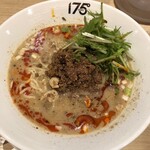
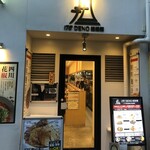
jnglog
3.40
■White Sesame Soup Dan Dan Noodles ¥1,000
I have tried cup ramen several times, but this was my first time visiting the actual restaurant. Instead of the default soupless option, I decided to go with the soup version on this day, with a rich flavor and medium spiciness level. The soup was indeed rich, with a thick and viscous texture, boasting the aroma of sesame and spices. Although the thickness of the soup was slightly unnatural, I enjoyed the type of soup. The noodles used were surprisingly a type of high-hydrated noodles, which had a chewy and unique texture. I look forward to trying their soupless options in the future, as well as their Jiro-style menu. Thank you for the meal.
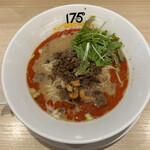
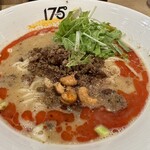
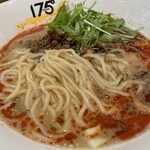
arn1030
3.40
I arrived at around 16:30. All the set meals were sold out, so I had to order a la carte. You can choose the level of spiciness and numbness. I think 0 or 1 is enough for numbness because you can adjust it with the Sichuan pepper on the table. The soup was rich and had just the right thickness, so the regular one seems quite refreshing. The vinegar on the table was black vinegar, which was not too strong and added a nice touch. It tasted like authentic Japanese tantanmen, with customizable levels of numbness and spiciness. The ratings may be a bit too high, but I enjoyed the meal. You can get a free topping like a soft-boiled egg or cheese by adding the restaurant on LINE.
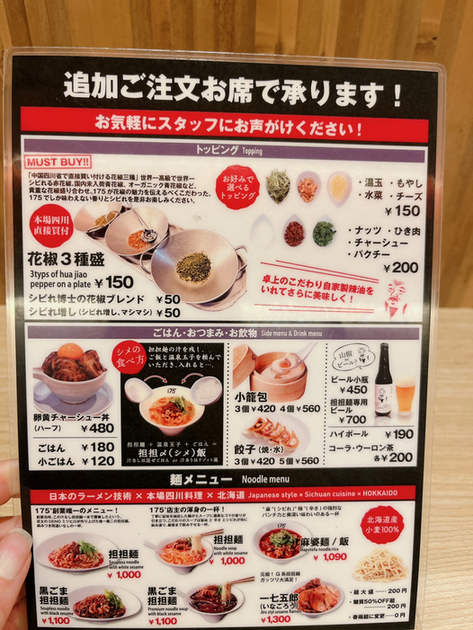
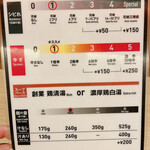
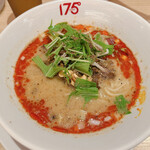
Kzkeeeee
3.50
Last time there was soup, so this time I went without soup. It was full as usual at 13:00 on weekdays, mostly men, but there were also a few women. It's a comfortable atmosphere for women to enter alone. I had the soupless tantanmen, spicy level 1, and added a boiled egg for free (which you get on your first visit). I also had a small bottle of Ebisu beer. The portion was large, so it seemed like I wouldn't be able to finish it unless I concentrated on eating. But I managed to finish it, and it gave me a strange sense of accomplishment. Spicy level 1 was enough, but it wasn't spicy enough for me, so I added some chili oil from the table. It was delicious!
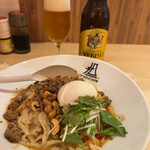
wasserbaum
3.00
I finally got to eat at a restaurant I've been wanting to go to but couldn't recently. The system involves buying a food ticket and the staff confirming various details when you hand it over. This time, I chose the spice level of 2 out of 5. The restaurant has a compact interior with counter seating and tables for up to two people. The chopsticks are shaped like bamboo, and the back of the ladle has a logo. After finishing the meal, there is a lingering spicy sensation around the mouth, so those who are not good with spicy food may want to choose a spice level of 1 or lower.
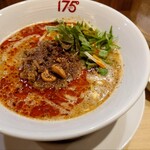
テッペイパパ
3.40
Lunch on 06/29 (Thu) ... 175°DENO Tantanmen with white sesame soup on the side at Tantanmen TOKYO ... 1,000 yen ... paid in cash ... Excellent service, fast service, delicious taste, good cold water, good portion size, good air conditioning, and visually appealing ... This is it! The taste of delicious Tantanmen!! The taste was complex with sourness, spiciness, sweetness, umami... It was delicious.
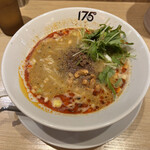
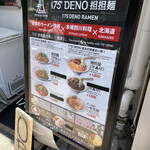
バーチー84208
3.30
I visited a tantanmen restaurant near Shinjuku Station! It was my third visit, about a year since my last. I ordered soupless tantanmen from the ticket machine! It's nice that you can choose the spiciness and amount of sansho pepper. It was delicious! Easy to eat and very good. I would like to visit again if I have the chance!
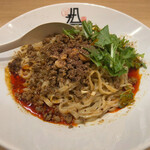
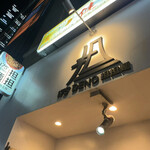
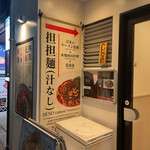
Email Login